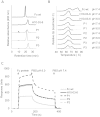Construction of pH-sensitive Her2-binding IgG1-Fc by directed evolution
- PMID: 24964247
- PMCID: PMC4314675
- DOI: 10.1002/biot.201300483
Construction of pH-sensitive Her2-binding IgG1-Fc by directed evolution
Abstract
For most therapeutic proteins, a long serum half-life is desired. Studies have shown that decreased antigen binding at acidic pH can increase serum half-life. In this study, we aimed to investigate whether pH-dependent binding sites can be introduced into antigen binding crystallizable fragments of immunoglobulin G1 (Fcab). The C-terminal structural loops of an Fcab were engineered for reduced binding to the extracellular domain of human epidermal growth factor receptor 2 (Her2-ECD) at pH 6 compared to pH 7.4. A yeast-displayed Fcab-library was alternately selected for binding at pH 7.4 and non-binding at pH 6.0. Selected Fcab variants showed clear pH-dependent binding to soluble Her2-ECD (decrease in affinity at pH 6.0 compared to pH 7.4) when displayed on yeast. Additionally, some solubly expressed variants exhibited pH-dependent interactions with Her2-positive cells whereas their conformational and thermal stability was pH-independent. Interestingly, two of the three Fcabs did not contain a single histidine mutation but all of them contained variations next to histidines that already occurred in loops of the lead Fcab. The study demonstrates that yeast surface display is a valuable tool for directed evolution of pH-dependent binding sites in proteins.
Keywords: Antibody engineering; Directed evolution; Fcab; Yeast surface display; pH-depending binding.
© 2014 The Authors. Biotechnology Journal published by Wiley-VCH Verlag GmbH & Co. KGaA, Weinheim. This is an open access article under the terms of the Creative Commons Attribution License, which permits use, distribution and reproduction in any medium, provided the original work is properly cited.
Figures




Similar articles
-
Engineered IgG1-Fc--one fragment to bind them all.Immunol Rev. 2016 Mar;270(1):113-31. doi: 10.1111/imr.12385. Immunol Rev. 2016. PMID: 26864108 Free PMC article. Review.
-
Directed evolution of Her2/neu-binding IgG1-Fc for improved stability and resistance to aggregation by using yeast surface display.Protein Eng Des Sel. 2013 Apr;26(4):255-65. doi: 10.1093/protein/gzs102. Epub 2012 Dec 23. Protein Eng Des Sel. 2013. PMID: 23267121
-
Fcab-HER2 Interaction: a Ménage à Trois. Lessons from X-Ray and Solution Studies.Structure. 2017 Jun 6;25(6):878-889.e5. doi: 10.1016/j.str.2017.04.014. Epub 2017 May 18. Structure. 2017. PMID: 28528777
-
Introducing antigen-binding sites in structural loops of immunoglobulin constant domains: Fc fragments with engineered HER2/neu-binding sites and antibody properties.Protein Eng Des Sel. 2010 Apr;23(4):289-97. doi: 10.1093/protein/gzq005. Epub 2010 Feb 11. Protein Eng Des Sel. 2010. PMID: 20150180
-
Structural analysis of Fc/FcγR complexes: a blueprint for antibody design.Immunol Rev. 2015 Nov;268(1):201-21. doi: 10.1111/imr.12365. Immunol Rev. 2015. PMID: 26497522 Review.
Cited by
-
Engineering an Anti-Transferrin Receptor ScFv for pH-Sensitive Binding Leads to Increased Intracellular Accumulation.PLoS One. 2015 Dec 29;10(12):e0145820. doi: 10.1371/journal.pone.0145820. eCollection 2015. PLoS One. 2015. PMID: 26713870 Free PMC article.
-
A novel one-step approach for the construction of yeast surface display Fab antibody libraries.Microb Cell Fact. 2018 Jan 9;17(1):3. doi: 10.1186/s12934-017-0853-z. Microb Cell Fact. 2018. PMID: 29316915 Free PMC article.
-
Engineered IgG1-Fc--one fragment to bind them all.Immunol Rev. 2016 Mar;270(1):113-31. doi: 10.1111/imr.12385. Immunol Rev. 2016. PMID: 26864108 Free PMC article. Review.
-
Monte Carlo Thompson sampling-guided design for antibody engineering.MAbs. 2023 Jan-Dec;15(1):2244214. doi: 10.1080/19420862.2023.2244214. MAbs. 2023. PMID: 37605371 Free PMC article.
-
The Masking Game: Design of Activatable Antibodies and Mimetics for Selective Therapeutics and Cell Control.ACS Cent Sci. 2021 May 26;7(5):724-738. doi: 10.1021/acscentsci.0c01448. Epub 2021 Apr 26. ACS Cent Sci. 2021. PMID: 34079893 Free PMC article. Review.
References
-
- Kontermann RE. Strategies for extended serum half-life of protein therapeutics. Curr. Opin. Biotechnol. 2011;22:868–876. - PubMed
-
- Maxfield FR, McGraw TE. Endocytic recycling. Nat. Rev. Mol. Cell. Biol. 2004;5:121–132. - PubMed
-
- Igawa T, Ishii S, Tachibana T, Maeda A. Antibody recycling by engineered pH-dependent antigen binding improves the duration of antigen neutralization. Nat. Biotechnol. 2010;28:1203–1207. - PubMed
-
- Sarkar CA, Lowenhaupt K, Horan T, Boone TC. Rational cytokine design for increased lifetime and enhanced potency using pH-activated histidine-switching. Nat. Biotechnol. 2002;20:908–913. - PubMed
Publication types
MeSH terms
Substances
Grants and funding
LinkOut - more resources
Full Text Sources
Other Literature Sources
Molecular Biology Databases
Research Materials
Miscellaneous

